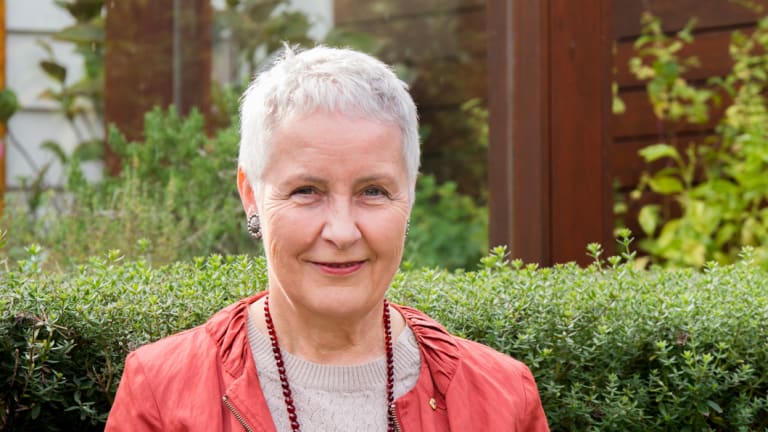'There's an awful lot of us': The symptoms women need to know

Diane Gardiner considers herself to be very lucky to be alive.
The Melburnian did not have “the foggiest” about the seriousness of the symptoms she was experiencing. Her GP didn’t either.
Like most women, Diane Gardiner didn’t know the symptoms of ovarian cancer.
It was early 2014 and Gardiner was feeling “wretched” with abdominal pain, weight gain, bloating and a need to go to the bathroom frequently.
At the time, as general manager of the Old Treasury Building museum in Melbourne and on the boards of several charities, her life was busy.
“I’d say to people ‘Oh I’m so tired’ and they’d say ‘Oh we’re all tired Diane – look at what you do.”
Still, she went to her doctor who dismissed her symptoms as “probably” diverticulitis.
Nearly six months later, in excruciating pain, she took herself to Emergency where doctors found a tumour “the size of a dinner plate” and drained three litres of fluid from her body. Gardiner was diagnosed with stage 3 ovarian cancer, the deadliest of all women’s cancers, with a survival rate of 45 per cent.
Jane Hall, the CEO of Ovarian Cancer Australia, says Gardiner's story is worryingly common.
“I think that’s the experience of many women,” says “Especially if they’re post menopausal or menopausal, doctors might think ‘oh you’re just a bit tired and run-down. Go and have a rest on the weekend and you’ll be right’… and this can go on and on and on.”
A new worldwide study by the World Ovarian Cancer Coalition, revealed that it takes an average of 32.5 weeks from the time women experience symptoms to the time they are diagnosed.
The first 10.7 weeks is the woman delaying going to the doctor, Hall explains.
“Women lead busy lives – working, care-giving, parenting – so firstly women may ignore their symptoms often because they’re just too busy,” she says. “Other women may feel that their complaints will not be taken seriously because their symptoms are quite generic.”
The study found that over two-thirds of women did not know anything about ovarian cancer prior to their own diagnosis and nine in 10 experienced multiple symptoms prior to their diagnosis.
The other side of the delay is the average of 21.8 weeks it takes doctors to diagnose it.
While ovarian cancer, currently the eighth most common cancer, is on the rise with incidence expected to grow 55 per cent by 2035, a doctor today may only see two cases of ovarian cancer in their career.
“It is difficult to diagnose because the symptoms are vague and generalised,” Hall says. “The four common symptoms are pelvic or abdominal pain, feeling full after eating a small meal, urgency or frequency of wanting to go to the toilet and a bloated stomach…
“The public and GPs need to know the symptoms. We don’t want women to get alarmed but if they do experience those symptoms persistently for a four to six week period then they should be going to see the doctor. We have a symptom diary we encourage women to fill out… because if you’ve got that type of record that speaks for itself with practitioners.”
Researchers don’t fully understand what causes ovarian cancer, although 15 to 20 per cent of cases are due to an inherited mutations – the most common one is the BRCA 1 and 2 (made famous by Angelina Jolie).
Age is also a factor (it is more common among women over 50), as is smoking, a poor diet and being overweight, endometriosis and not having children.
Understanding the Risks
“It’s a mind-bendingly cruel disease,” Hall says. “It’s not just one type of cancer – it’s a whole group of different subtypes with different molecular structures and different trajectories.”
Despite this, and the poor survival rate, she is “very optimistic” about future prognoses. She mentions the investment in breast cancer in the last 15 years has resulted in a 90 per cent survival rate as well as promising advances in genomics and personalised medicine.
Gardiner believes her access to an ovarian cancer specialist saved her life. “This study has shown that I’m talking to you today because I had an ovarian cancer gynaecological specialist. If I didn’t have that person operating on me I would be dead.”
Now in her 70s, she has since received a Member of the Order of Australia for her work, become a grandmother and, after living with the uncertainty of her diagnosis, given herself “permission” to live.
She urges other women to become familiar with the symptoms and get themselves checked out if they are concerned.
“It’s a lesser known cancer,” she says, “but there’s an awful lot of us who have it.”
Source: Read Full Article





